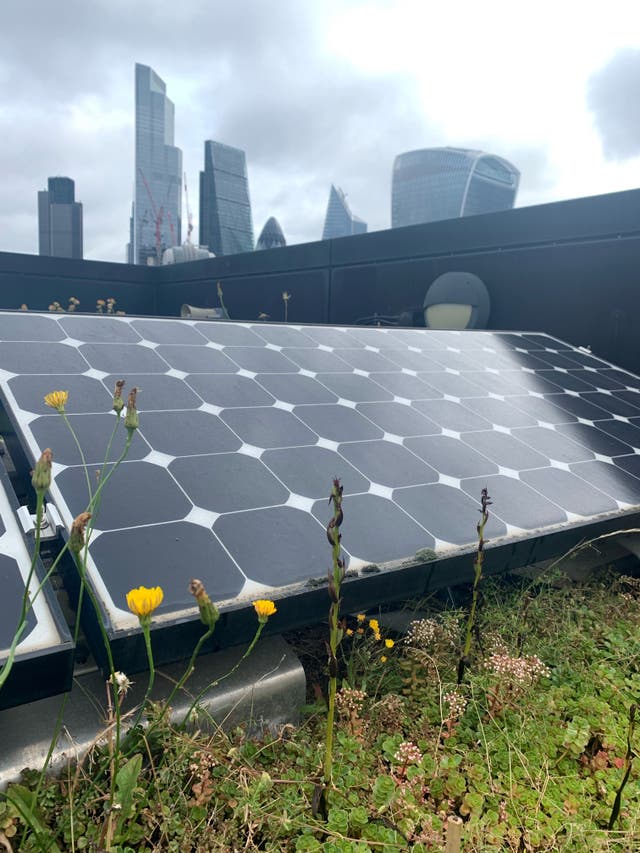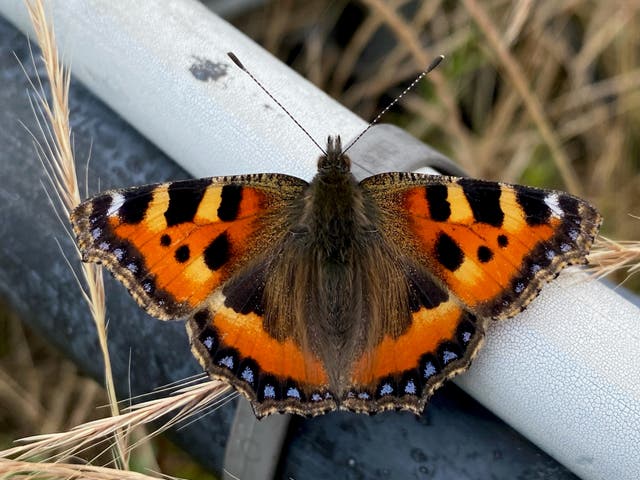Rare orchids to flood resilience: How can green roofs help to tackle the climate and nature crisis?
Eleven stories high in the heart of the City of London, there is a hidden haven for wildlife. Around 159 species of plants are flourishing on the rooftop of Nomura, a Japanese bank. By day, orchids, daisies and wild herbs provide food to 17 species of bees. At night, the bright yellow flowers of mullein plants bloom in the moonlight, tempting London’s moths. It is here that an orchid thought to be extinct in the UK was recently discovered growing among the roof’s solar panels. The small-flowered tongue orchid – so named because its flowers resemble protruding tongues – has only been found growing wild in the UK once before, in 1989. It’s still a mystery how the orchids made it onto the roof, though ecologist Mark Patterson, who manages the bank’s 10-year-old rooftop garden, suspects that the flowers’ seeds hitched a ride on winds blowing over from the Sahara. “Orchid seeds are as small as specks of dust,” he tells The Independent. “So my theory is they blew over before establishing themselves.” On the Friday morning when The Independent visited Nomura’s green roof, he was collecting leaves from the flowers to send to experts at Kew Gardens. “They’re going to analyse the DNA from the samples. That might be able to tell us what region the seeds originated from,” he explains. [caption id="" align="alignnone" width="640"] A colony of small-flowered tongue orchids (centre and right) were discovered on a London rooftop after not being seen in the UK since 1989. SOURCE: Daisy Dunne[/caption]
Nomura’s green roof is one of 700 spread across central London, with the capital boasting more such idylls than other parts of the country. According to the Greater London Authority, a “green roof” is a “a roof or deck where vegetation or habitat for wildlife is deliberately established”.
As well as providing a safe space for rare wildlife, building green roofs in cities can offer a host of other benefits, ranging from improving local air quality to helping build resilience against worsening extreme weather events, says Dr Michael Hardman, a senior lecturer in urban geography at the University of Salford.
“There’s clear evidence out there that green roofs can mitigate against things like the urban heat island effect and flood events,” he tells The Independent. “In terms of climate change, they are definitely an important tool.”
The “urban heat island effect” is a term for how cities are typically hotter than rural areas. Major UK cities, such as London, Manchester and Birmingham, can at times be up to 5C hotter than their surrounding rural areas, research shows. The effect is caused by a combination of densely packed buildings and roads, which trap in heat, as well as air pollution, industrial activity and high amounts of energy use by homeowners.
Research shows that the urban heat island effect is likely to intensify in UK cities as the planet continues to warm.
Green roofs can help to tackle urban heat by providing a local cooling service. This is largely because plants naturally absorb water through their roots and later release it into the air as moisture, which has a cooling effect on the surrounding area.
At Nomura’s rooftop garden, this cooling effect is largely enough to allow the bank to cut back on the use of air conditioning in the summer, Mr Patterson says. “If all the buildings in this area had green roofs, it would probably reduce the temperature on a hot day by a degree or two,” he adds.
[caption id="" align="alignnone" width="640"]
A colony of small-flowered tongue orchids (centre and right) were discovered on a London rooftop after not being seen in the UK since 1989. SOURCE: Daisy Dunne[/caption]
Nomura’s green roof is one of 700 spread across central London, with the capital boasting more such idylls than other parts of the country. According to the Greater London Authority, a “green roof” is a “a roof or deck where vegetation or habitat for wildlife is deliberately established”.
As well as providing a safe space for rare wildlife, building green roofs in cities can offer a host of other benefits, ranging from improving local air quality to helping build resilience against worsening extreme weather events, says Dr Michael Hardman, a senior lecturer in urban geography at the University of Salford.
“There’s clear evidence out there that green roofs can mitigate against things like the urban heat island effect and flood events,” he tells The Independent. “In terms of climate change, they are definitely an important tool.”
The “urban heat island effect” is a term for how cities are typically hotter than rural areas. Major UK cities, such as London, Manchester and Birmingham, can at times be up to 5C hotter than their surrounding rural areas, research shows. The effect is caused by a combination of densely packed buildings and roads, which trap in heat, as well as air pollution, industrial activity and high amounts of energy use by homeowners.
Research shows that the urban heat island effect is likely to intensify in UK cities as the planet continues to warm.
Green roofs can help to tackle urban heat by providing a local cooling service. This is largely because plants naturally absorb water through their roots and later release it into the air as moisture, which has a cooling effect on the surrounding area.
At Nomura’s rooftop garden, this cooling effect is largely enough to allow the bank to cut back on the use of air conditioning in the summer, Mr Patterson says. “If all the buildings in this area had green roofs, it would probably reduce the temperature on a hot day by a degree or two,” he adds.
[caption id="" align="alignnone" width="640"] Tortoiseshell butterflies are one of many insects found on Nomura’s green roof. SOURCE: Mark Patterson[/caption]
The bank’s green roof also plays a role in reducing flood risk in the city. “Every inch of soil you have on a green roof absorbs five per cent more water, so that’s five per cent less water that’s running off into drains,” he says.
A study conducted in Newcastle in 2016 found that a “city-wide deployment of green roofs” could reduce travel disruption from flooding by around a quarter. The authors of the research say that green roofs, along with more traditional defences such as flood walls, must be part of plans to cope with more extreme downpours.
The need to prepare for worsening heatwaves and floods in the UK is greater than ever. Earlier this month, the UK’s independent climate advisory group, the Climate Change Committee, warned that the country is now less prepared for the climate crisis than it was five years ago as a result of government inaction in the face of rising risks.
Increasing the number of green spaces in cities will be key to helping the country’s urban populations cope with increasing heat and worse floods, according to their assessment.
Despite recognising the benefits of green roofs, the UK is currently behind other countries when it comes to building them, says Dr Hardman.
“We need to look to countries, like Denmark, which have both the financial incentives and the planning incentives,” he says. “In Denmark, if a building’s slope angle is under a certain amount, it’s actually mandatory to put a green roof on. We need to be more innovative with our policies.”
He added that, at present, not enough is being done to ensure that the social benefits of green roofs can be accessed by disadvantaged groups.
“All the green roofs in Manchester that I know of are very inaccessible, they are closed to the public and you need a health and safety person to take you up there,” he says. “To me that’s a huge barrier to green roofs. The social benefits just aren’t there at the moment, as they are for other types of green infrastructure like parks”.
Tortoiseshell butterflies are one of many insects found on Nomura’s green roof. SOURCE: Mark Patterson[/caption]
The bank’s green roof also plays a role in reducing flood risk in the city. “Every inch of soil you have on a green roof absorbs five per cent more water, so that’s five per cent less water that’s running off into drains,” he says.
A study conducted in Newcastle in 2016 found that a “city-wide deployment of green roofs” could reduce travel disruption from flooding by around a quarter. The authors of the research say that green roofs, along with more traditional defences such as flood walls, must be part of plans to cope with more extreme downpours.
The need to prepare for worsening heatwaves and floods in the UK is greater than ever. Earlier this month, the UK’s independent climate advisory group, the Climate Change Committee, warned that the country is now less prepared for the climate crisis than it was five years ago as a result of government inaction in the face of rising risks.
Increasing the number of green spaces in cities will be key to helping the country’s urban populations cope with increasing heat and worse floods, according to their assessment.
Despite recognising the benefits of green roofs, the UK is currently behind other countries when it comes to building them, says Dr Hardman.
“We need to look to countries, like Denmark, which have both the financial incentives and the planning incentives,” he says. “In Denmark, if a building’s slope angle is under a certain amount, it’s actually mandatory to put a green roof on. We need to be more innovative with our policies.”
He added that, at present, not enough is being done to ensure that the social benefits of green roofs can be accessed by disadvantaged groups.
“All the green roofs in Manchester that I know of are very inaccessible, they are closed to the public and you need a health and safety person to take you up there,” he says. “To me that’s a huge barrier to green roofs. The social benefits just aren’t there at the moment, as they are for other types of green infrastructure like parks”.
Source Independent